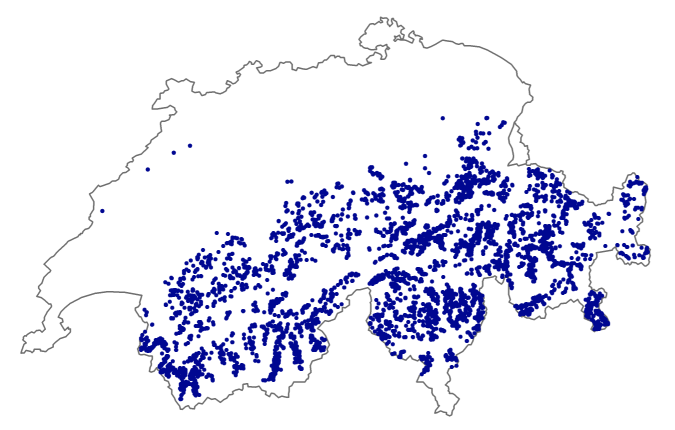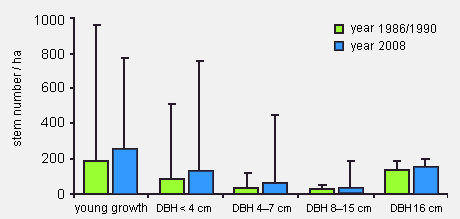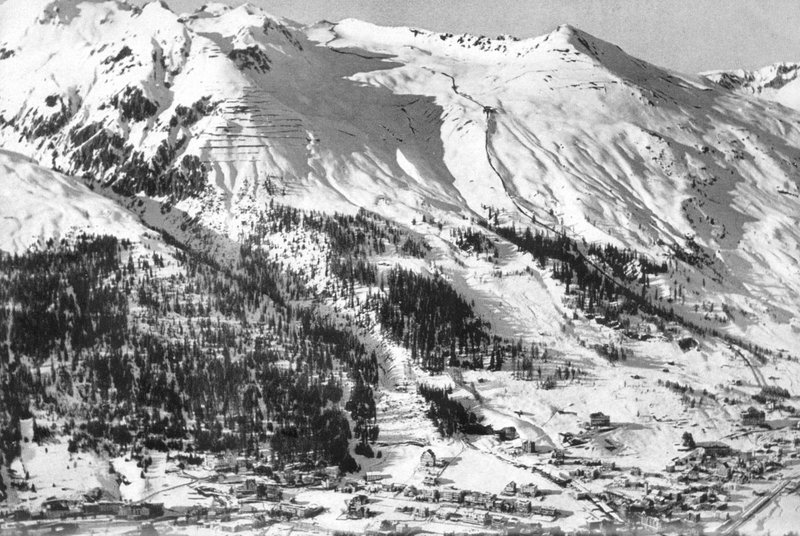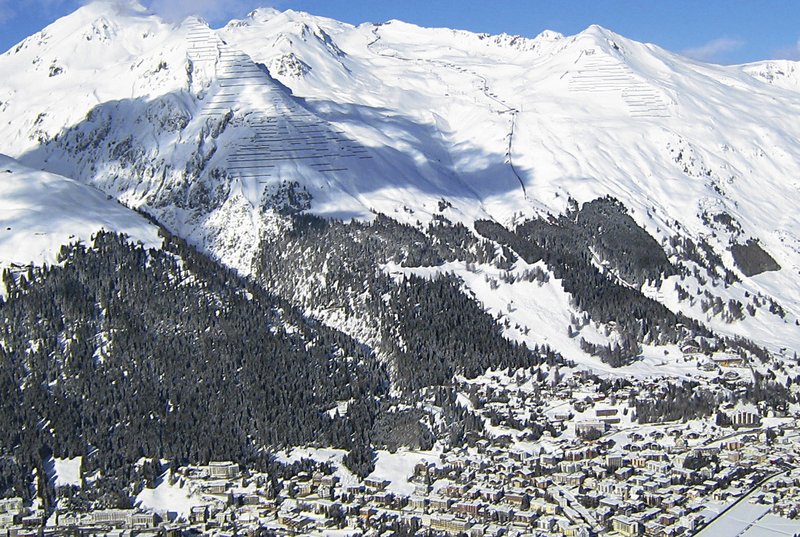In Swiss alpine areas forests have increased by more than 30% since the end of the 19th Century (Fig. 1). They have noticeably spread into Alpine pastures whose management is no longer worthwhile. Furthermore, forests in alpine areas have become much denser, especially in places where they were over-used in earlier centuries. These changes are leading to increasingly controversial discussions because, among other things, large sums of public money are being invested, not only in the management of slopes, which is working against forest expansion, but also in the improvement of natural hazard protection.
Avalanche release areas and forest changes
In a GIS-based analysis scientists from the Federal Research Institute (WSL) have recorded all changes in forests between the last two Swiss land use statistic inventory periods from 1979 to 1985 and 1992 to 1997 for all mountain areas in Switzerland above 1200 a.s.l. (Fig. 2). For every hectare a distinction was made between the following categories:
- a) "dense forest" (coverage >60%, tree height > 3m)
- b) "open forest" (coverage 20-60%, tree height > 3m)
- c) "no forest" (coverage < 20%)
The scientists correlated these changes with potential avalanche release area models in and outside of forest areas, and to other environmental factors such as “height above sea level”, “steepness” or “distance from the highest tree line”, and then evaluated the results statistically.

Fig. 2 - Forest spread in potential avalanche release areas. The dots represent sample areas from Swiss land use statistics (where new protection forests have become established in potential avalanche release areas between 1985 and 1997).
Forests are expanding into potential avalanche release areas
The total forest area in Switzerland, in the surveyed alpine areas, has increased by 4% during the past 12 years. The expansion of forest into steep areas, with gradients of more than 30°, has been even greater; as has the increase of forest covered slopes which due to their topography were modelled as potential avalanche release areas. Alone in potential avalanche release areas above 1200m a.s.l. the increase in forest has been around 5800 hectares. Montane and sub-alpine bush and grazing areas up to 200m below the potential tree line are showing a strong tendency to become ingrown.
Existing avalanche protection forests are becoming denser
A transition from open to dense forests could be discerned on 7540 ha at 1200m a.s.l. in the twelve years between the last two land use statistic inventories (Fig. 1). Whilst such transitions in avalanche release areas appeared just as often as in other areas, the forests have become significantly denser in steep terrain (>30°). Forests in the 400 m below the potential tree line have become much less dense. Forest areas which have become sparser due to natural disturbances or silvicultural measures, or which have been transferred to other uses have changed the effectiveness of avalanche protection very little. The majority of these areas could be found at lower altitudes, on less steep slopes and outside of potential avalanche release areas.
Forest development changes avalanche potential
The sparser the forest the less it protects from avalanches. Other influences also play a role, such as the length and width of forest clearings, and the composition of the tree species. Available knowledge is based largely on inventories of avalanche release areas from the 1980’s. Around 20 years after these inventories 23 avalanche release areas, in open sub-alpine forests in the timber line areas, were re-visited to examine natural forest dynamic.
This confirmed that the protection effectiveness in most of the former forest avalanche release areas has improved. Changes are limited, for the time being, to rejuvenation (trees with a DBH<8cm, Fig. 3) and show large variations depending on site conditions: especially in forests where vegetation competition is strong and there is very little rotting wood, or forests which are constantly being disturbed by movements of snow have hardly changed in regards to protection effectiveness.
Field recordings from former release areas of forest avalanches confirm the evaluation of the Swiss Use of Land data: Protection forests are returning to many areas and will be more effective. However, in areas around the tree line this is taking place very slowly and varies greatly according to terrain conditions.

Fig. 3 - Development of different diameter classes in former release zones of forest avalanches since the first recordings from 1986/1990 to 2008. (Data Forest avalanche project; Mayer-Grass and Schneebeli 1992 and Diploma Thesis M. Ulrich).
Protective effects can be controlled
The analyses indicated that for improving natural avalanche protection it is relevant where subsidies for mountain farming and protection forests are paid or not paid. It can also be seen that effective avalanche protection forests do not spring up everywhere by themselves. In view of the spatially differentiated forest dynamic in the mountains and the (evermore) scarcity of subsidies then not all contributions allotted to the management of steep meadows and pastures make sense.
The usefulness to the community of compensation paid for agricultural and forestry management services in mountain areas should not be in any way called into question. However, in some places it would seem to make more sense if compensation paid to mountain forestry and protection forests be looked at and paid out in a more regional context. In this way natural protection from natural hazards and the appreciation of other environmental services could generally be optimised.
Translation: Dawn Meister (Affoltern a. A.)



